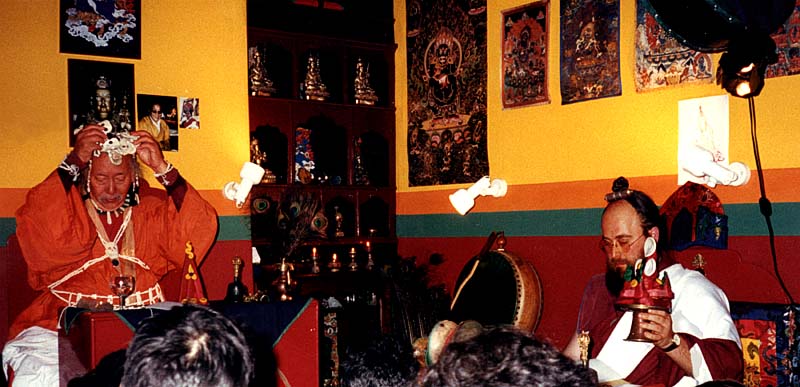
Wearing a Takdröl
accounts of how a takdröl comes to be worn in the hair
Ralzhig Pema Legden wrote the following account soon after the paranirvana of Chhi’mèd Rig’dzin Rinpoche:
If one has an intimate relationship with one’s Lama, there are likely to be private occasions where what takes place must be placed under vows of secrecy – sometimes for the duration of the lifetime of the Lama, and sometimes in perpetuity. I could never imagine anyone more perfect in the practice of secrecy, or in respecting speech precepts, than Ngak’chang Rinpoche. I was witness to an extraordinary event about which Ngak’chang Rinpoche has never spoken publicly. This episode was witnessed by Khandro Déchen, by Ngala Nor’dzin Pamo and Ngala ’ö-Dzin Tridral and by all the long term disciples now with Ngak’chang Rinpoche and Khandro Déchen – such as Ngakma Lé-kyi. In speaking of this now, all of us are tempered by the pathos of knowing that the time for disclosure, has arrived. For me, this is confirmed by the fact that we shall never set eyes on Chhi’mèd Rig’dzin Rinpoche’s shining face again — at least, not looking as he did.
This story took place during Chhi’mèd Rig’dzin Rinpoche’s second visit to Britain in 1988, in Ngak’chang Rinpoche’s then home in Diana Street, Roath, a suburb of Cardiff. At the beginning of that week Ngak’chang Rinpoche chose a relatively private moment for a simple gesture which I found enigmatic: he formally presented his takdröl to Chhi’mèd Rig’dzin Rinpoche. This takdröl had been given to Ngak’chang Rinpoche by Lama Yeshé Dorje in India, to confirm his empowerment to teach and take students; along with an official letter to that effect. The takdröl was a smaller model of the one Lama Yeshé Dorje used to wear. But when Ngak’chang Rinpoche had returned to Britain he had begun to meet with the kind of obstacles that Khyungchen Aro Lingma predicted would befall the teaching career of the tulku of Aro Yeshé.
Ngak’chang Rinpoche in those days went incognito as a trülku, but it was during this week in Cardiff that Chhi’mèd Rig’dzin Rinpoche spoke publicly about Aro Yeshé’s previous incarnation – ’a-Shul Pema Legden. Ngak’chang Rinpoche used to say that, over and above the past life memory he already possessed, this opened the floodgates to the extraordinarily detailed recollections of the Aro Gar, its occupants and their lineages, which he has since been accumulating in a lineage history and augmenting from time to time. If other great Lamas have possessed past life memory of such depth of detail, about so many great individuals, some of them otherwise unknown, it must be kept secret in their lineages, because nothing of comparable quality seems ever to have been published.
Meanwhile Ngak’chang Rinpoche tended to encounter resentment and resistance from those who put a high value on their opinion that he was not entitled to be wearing an item of such prestigious connotation. Without resorting to the indignity of defending himself, by reference to the authentic instrument of authority which he properly possessed, Ngak’chang Rinpoche chose a path of discretion. He has frequently made the point that a Lama does not engage in argument. Shakyamuni Buddha said ‘Worldly beings argue with me. I am not going to argue with them.’ Dung-sé Thinley Norbu Rinpoche, who quotes this remark of Shakyamuni Buddha in White Sail, said, ‘If you argue with a fool you become like a fool yourself.’ An Anglican cleric in an English village used to be known as ‘the parson’. Parson is a corruption of ‘person’, meaning ‘the person of Christ’. The village priest, like the ‘village Ngakpa’, was supposed to be the local embodiment of the tradition. In a sublime sense he literally ‘impersonated’ its source. Similarly in Vajrayana the Lama’s duty is to present the teachings and represent them, to the extent that students can practice seeing their teachers as embodying the lineage and its very founders. But nobody is obliged to like them, agree with them, or follow them – the lineage, its founders, the Lamas, or their teachings. So Ngak’chang Rinpoche resorted to keeping his takdröl concealed whilst fulfilling the commitment of a takdröl holder, not to allow oneself to be physically distanced from this article, which places the cause of liberation through the sense-field of touch. One is supposed to keep it at least in the same room, if not on one’s person. This is an example of deliberately keeping a vow even when the circumstances supporting it seem to have disappeared, when the vow might appear to have no calculable significance any longer apart from the sheer phenomenal fact of one’s persistence in it. But maintaining the fourteen Root Vows in the face of such an earthquake of adversity is to nail down profound vajra reference-points. One rivets one’s refuge, along the fault-lines of relative rationale, against subsidence into the debris of dualistic self-destruction.
And now with great integrity and a further display of discretion, Ngak’chang Rinpoche had offered this takdröl back to Chhi’mèd Rig’dzin Rinpoche. As Chhi’mèd Rig’dzin Rinpoche was a Tsa-wa’i Lama of Lama Yeshé Dorje, it was appropriate to show recognition of his complete authority over this situation and his unique capacity to resolve it. The first visible consequence that week was that Chhi’mèd Rig’dzin Rinpoche wore the takdröl in his own hair. We were uncertain as to how to interpret this of course, but uncertainty in such a moderate degree scarcely featured on our radar, in a week in which nothing that happened was capable of banal interpretation, or even any interpretation of ours at all.
